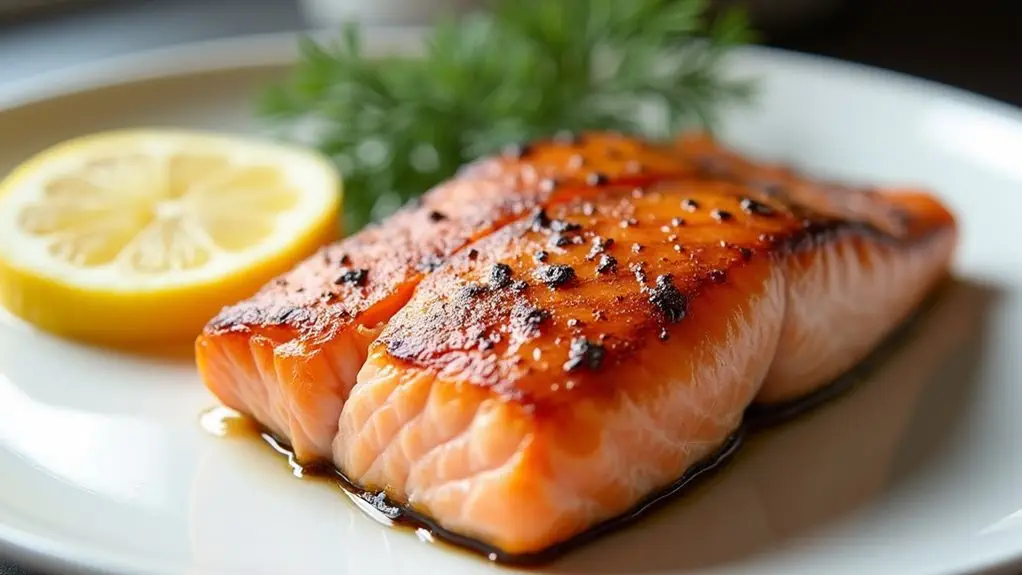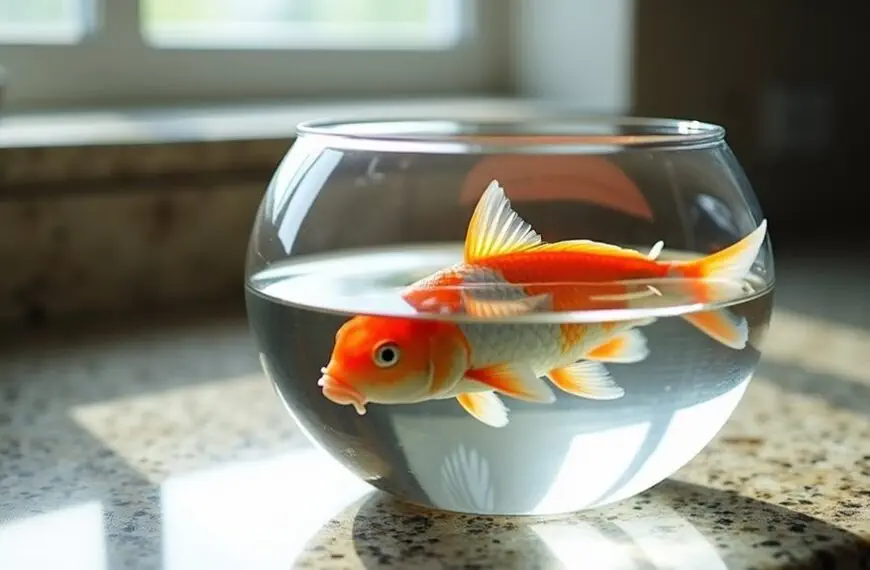For your first seafood adventure, you'll want to start with mild-flavored fish that won't overwhelm your taste buds. Tilapia, cod, and halibut are perfect beginner-friendly options, offering a subtle taste and firm, flaky texture that's easy to enjoy. These fish are also packed with protein and nutrients while being low in calories, making them a healthy choice for newcomers. You can't go wrong with simple cooking methods like baking or pan-frying – just season with lemon, herbs, and a touch of olive oil. Once you've mastered these starter fish, a whole ocean of culinary possibilities awaits.
Contents
Understanding Mild-Flavored Fish Options
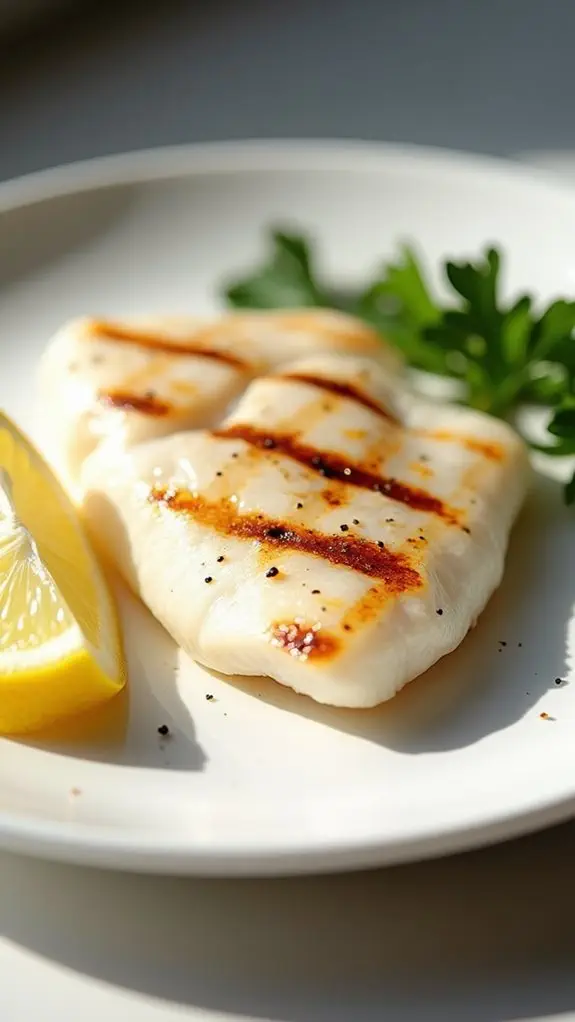
When it comes to trying fish for the first time, mild-flavored options offer the perfect introduction to seafood. You'll find that fish like tilapia, cod, and halibut are excellent choices because they're gentle on your palate and won't overwhelm you with intense fishy flavors.
These friendly options provide numerous mild fish benefits, including high protein content and essential nutrients, while keeping the calories low. Their nutrient-rich profiles make them particularly healthy choices for those watching their diet. Many mild fish varieties are quick cooking options, taking just minutes to prepare perfectly.
You'll love how versatile these fish are when it comes to cooking mild fish at home. Their delicate, buttery taste pairs beautifully with simple seasonings like lemon, garlic, and fresh herbs.
If you're nervous about preparing fish, don't worry – these varieties are incredibly forgiving! Whether you're baking, grilling, or pan-frying, they maintain their pleasant texture and taste. Think of them as the "starter pack" of the seafood world.
For the best experience, try starting with tilapia or cod. They're widely available, budget-friendly, and have a sweet, clean taste that even picky eaters enjoy.
Plus, their firm yet flaky texture means they won't fall apart during cooking, making your first seafood adventure a delicious success.
Best Fish For Seafood Newcomers
For seafood newcomers, selecting the right fish can make all the difference between developing a lasting appreciation or swearing off seafood entirely. If you're just starting your seafood journey, you'll want to focus on fish with mild flavors and pleasing textures that won't overwhelm your palate. When preparing these fish, aim for an internal temperature of 145 degrees Fahrenheit for safe, ideal donness. The American Heart Association suggests making seafood a regular part of your diet, as twice-weekly consumption can significantly benefit your heart health.
Halibut and cod are excellent starter choices due to their firm, flaky texture preferences and subtle taste. You'll find these fish readily accept various seasoning suggestions without losing their natural appeal.
Salmon, while slightly bolder in flavor, offers a buttery texture that many first-timers find irresistible, especially when baked with simple seasonings like lemon and herbs.
Don't overlook flounder, which brings a delicate sweetness that's perfect for those who prefer lighter fare. If you're feeling a bit more adventurous, try mahi-mahi – it's versatile enough to handle different cooking methods and seasonings while maintaining its mild profile.
Healthy White Fish Choices
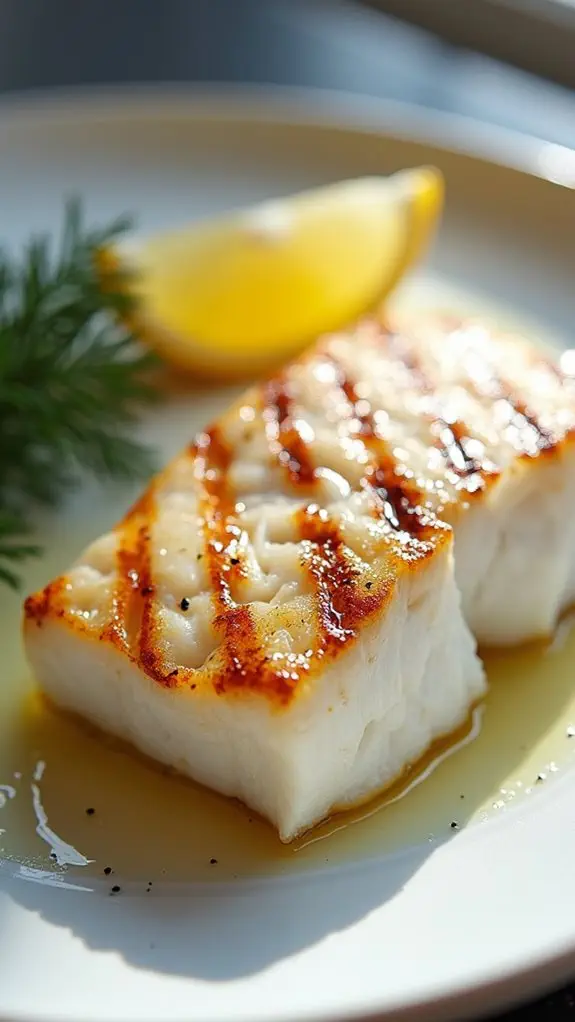
When you're ready to try white fish for the first time, you'll find lots of mild, flaky options that won't overwhelm your taste buds.
Light, healthy choices like cod and flounder are perfect starting points since they're low in mercury and packed with protein. These versatile fish are excellent in vitamins that support your body's energy and nerve function. The minimal fat content makes them an ideal choice for those seeking lean protein sources.
You'll love how easy these fish are to prepare – just pop them in the oven with a bit of lemon and butter, and you're set for a nutritious meal that won't make you feel like you're swimming in unfamiliar waters.
Mild and Flaky Options
Five excellent starter fish stand out for their gentle flavors and delicate textures. If you're new to seafood, you'll love how cod offers a slightly sweet taste that's never overwhelming, making it perfect for your first fish adventure. White fish options are typically lower in fat and calories compared to other fish varieties. Wild Alaskan Pollock is an excellent choice since it's always wild-caught from clean northern Pacific waters.
Halibut's tender flesh will surprise you with its versatility – you can grill it, bake it, or pan-sear it without any fuss.
Looking for something that'll make you forget you're eating fish? Try haddock, with its mild fish profile and flaky texture that's sure to win you over. It's especially delicious when simply baked with a squeeze of lemon.
Pollock might be familiar to you from fish sticks (yes, that's what they're often made of!), and its gentle flavor makes it a fantastic gateway into the world of seafood.
Finally, there's sole, which brings a subtle buttery taste with just a hint of nuttiness. You'll be amazed at how it transforms with just a simple brown butter sauce or a drizzle of lemon-herb butter.
Low Mercury White Fish
Safety-conscious seafood lovers will appreciate these low-mercury white fish options that deliver both nutrition and peace of mind.
When you're just starting your seafood journey, it's smart to choose fish that are both gentle on the palate and safe to eat regularly. Methylmercury accumulation increases as you move up the food chain, which is why these smaller white fish are safer choices.
Flounder benefits include exceptionally low mercury levels (just 0.003-0.121 ppm) and a healthy dose of vitamin B12, making it an excellent choice for beginners. Shrimp and scallops are also excellent starter options with very low mercury.
You'll love its delicate texture, which is perfect for those who aren't sure about "fishy" flavors.
Looking for versatile cod recipes? This low-mercury fish is packed with iodine and lean protein, making it ideal for everything from fish tacos to classic fish and chips.
Don't overlook pollock and haddock, either.
They're both swimming with health benefits and contain minimal mercury (pollock at just 0.031 ppm).
If you're pregnant or nursing, you can safely enjoy these white fish choices two to three times per week.
Remember to keep portions to about 4 ounces for adults – that's roughly the size of your palm, so you won't need a scale to get it right!
Easy Cooking Methods
Now that you've selected a healthy white fish, preparing it doesn't have to be complicated. With some easy meal prep techniques, you'll be cooking like a pro in no time.
The simplest method is baking – just preheat your oven to 350°F, season your fish with a bit of lemon and herbs, and let it cook for about 15-20 minutes until it flakes easily with a fork.
If you're looking for something quicker, try pan-frying with a touch of olive oil. You can create healthy marinades using lemon juice, garlic, and your favorite herbs for extra flavor without adding unnecessary calories.
For a virtually fat-free option, steaming is your best friend – it's practically foolproof and keeps all those good nutrients locked in.
Grilling is another fantastic choice that'll give you that slight char and smoky flavor. Just brush your fish with olive oil, add some seasonings, and grill until it's perfectly flaky.
Popular Beginner Fish Selections
Selecting the right fish for your first seafood experience can make all the difference in developing a lifelong appreciation for this healthy protein. When you're just starting out, you'll want to focus on fish that are both sustainable and beginner-friendly.
For freshwater options, you can't go wrong with bluegill or rainbow trout. These fish are plentiful, easy to catch if you're interested in beginner fishing, and offer mild, approachable flavors that won't overwhelm your palate. Additionally, consider social behavior when choosing your fish, as it can enhance your overall enjoyment of the experience.
Tilapia and perch are also excellent choices, featuring delicate tastes and versatile cooking options.
If you're leaning toward saltwater varieties, cod and haddock should be at the top of your list. They're firm, tender, and wonderfully adaptable in the kitchen.
Sea bass and sole offer slightly buttery textures that'll make you wonder why you haven't tried fish sooner!
You might want to skip tuna, red snapper, and halibut for now – they're trickier to prepare and might discourage you if things don't turn out perfectly.
Preparing Fish For First Time
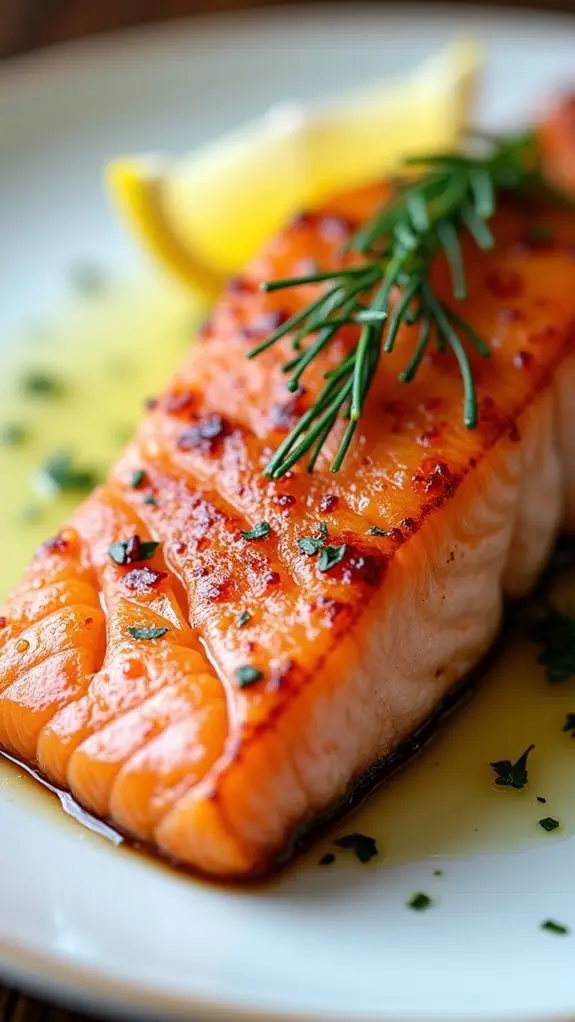
The proper preparation of fish is key to a successful first-time cooking experience. Before you plunge into cooking essentials, make sure you've cleaned your fish thoroughly and removed any scales or skin that might affect the final taste.
If you're starting with a whole fish, you'll want to remove the innards and cut it into manageable pieces – don't worry, it's not as scary as it sounds!
For your first attempt at cooking fish, you'll find that sautéing or baking are fantastic methods to bring out natural fish flavors.
If you're feeling a bit nervous, try the foolproof "en papillote" method – it's just a fancy way of saying "wrapped in parchment paper!" This technique helps lock in moisture and prevents your fish from drying out.
Simply add some lemon slices, herbs, and a splash of white wine before sealing the package.
Safe Cooking Methods
When you're starting your fish-cooking journey, it's best to stick with simple, foolproof methods like pan-searing and baking.
You'll find that pan-searing gives you a perfect golden crust while keeping the inside moist and tender, making it an excellent choice for beginners who want quick results.
Basic baking techniques are equally beginner-friendly, and they'll let you get comfortable with cooking fish without worrying about complicated steps or timing issues.
Easy Pan-Seared Methods
Pan-searing fish up to perfection doesn't require professional culinary skills, but it does demand attention to a few critical steps.
First, you'll want to choose the right fish seasoning – a simple sprinkle of salt on both sides about 20 minutes before cooking works wonders. When it comes to cooking oils, stick with high-heat options like grapeseed, safflower, or peanut oil.
Your best friend for pan-searing will be a cast iron or steel pan (sorry, non-stick lovers!).
Here's a pro tip: let your pan get seriously hot before the fish touches it. If you're working with skin-on fillets, make a few diagonal cuts in the skin to prevent it from doing the fish-curl dance in your pan.
For fatty fish like salmon or striped bass, you'll get the best results. Start with the skin side down and let it cook until it's golden brown – you'll know it's ready when it doesn't stick to the pan anymore.
Once you flip it, add a pat of unsalted butter for extra flavor. Finally, a squeeze of lemon or lime will make your perfectly seared fish sing!
Simple Baking Techniques
Looking to master a foolproof way to cook fish? Baking fish is one of the easiest and most reliable methods you'll find, especially when you're new to cooking seafood.
You'll love how simple it's to create a delicious, flaky dish in your oven.
Start by preheating your oven to 400°F and grabbing an 11×7-inch baking dish. Give it a quick coating of oil to prevent sticking – trust me, you don't want your beautiful fish falling apart!
When it comes to seasoning techniques, you can't go wrong with the classic combination of seasoned salt, pepper, and a sprinkle of paprika. For extra flavor, add a pat of butter and some fresh dill.
Cover your fish with foil and pop it in the oven for 15-20 minutes. Here's a pro tip: start checking it at the 15-minute mark – nobody likes overcooked fish!
You'll know it's ready when it flakes easily with a fork and reaches an internal temperature of 145°F. Before serving, finish with a squeeze of fresh lemon to really make those flavors sing.
Seafood Shopping Tips
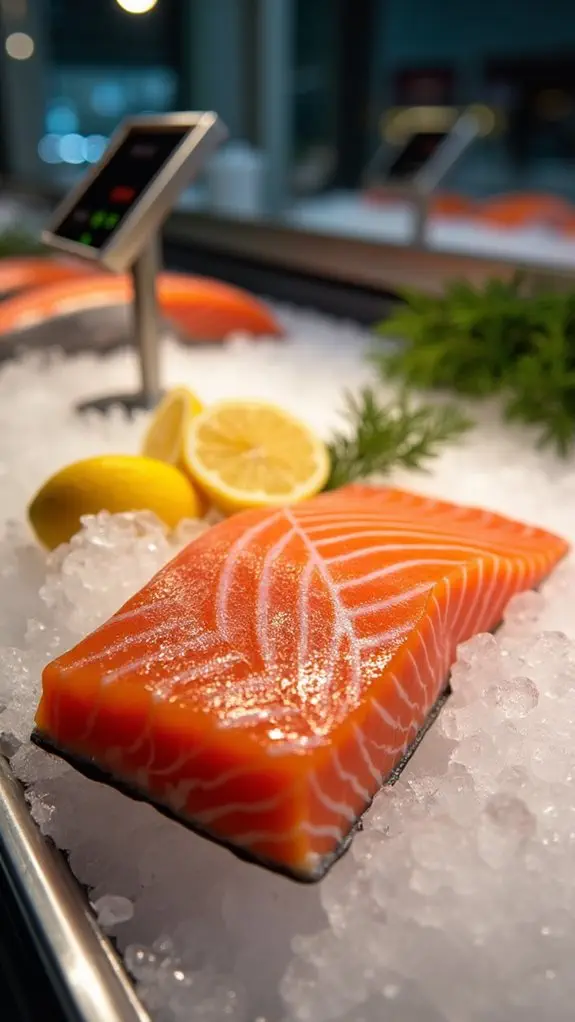
Successfully selecting fresh seafood requires knowledge of key visual, olfactory, and textural indicators. When you're at the market, trust your senses to guide you toward the freshest catch.
Look for fish with bright, clear eyes that seem to stare right back at you, and scales that shimmer like nature's disco ball. The gills should be a vibrant red or pink, not dull or brownish.
Don't be shy about giving your potential dinner a sniff – fresh fish shouldn't smell "fishy" at all. Instead, you're looking for a subtle ocean breeze scent, or sometimes no smell at all.
When it comes to texture, gently press the flesh – it should bounce back like a tiny trampoline, not leave a lasting dent. For proper seafood storage, make sure the fish you're eyeing is displayed on plenty of ice, and you'll want to keep it well-chilled once you get home.
Recommended Fish Serving Sizes
Serving the right amount of fish can make or break your first seafood experience. When you're new to eating fish, you'll want to start with portions that aren't overwhelming but still satisfy your appetite. For most adults weighing around 160 pounds, you're looking at about 6 ounces of cooked fish – that's roughly the size of your hand.
Different fish types come with different serving recommendations. If you're trying white fish like cod or haddock, aim for about 150g per person – perfect for beginners since these varieties have a mild flavor. For salmon, which is a bit richer, you'll want to stick to 120-140g per serving. Think of it as nature's portion control!
Here's a handy tip: if you're lighter or heavier than 160 pounds, adjust your serving size by an ounce for every 20-pound difference.
And remember, you don't need to be too precise – using the "hand rule" works great for eyeballing portions. If you're serving fish as a starter, cut these portions in half, and you'll be all set for a perfect first-time fish experience.
Frequently Asked Questions
How Long Can I Store Fresh Fish in the Refrigerator?
You can store fresh fish in your refrigerator for up to 2 days if you maintain a temperature of 40°F or below. Make sure you're keeping it covered and in a single layer for ideal freshness.
Which Seasonings Work Best for Masking Strong Fishy Flavors?
You'll find acidic ingredients like lemon and lime work wonders for flavor balancing. Try seasoning combinations with garlic, ginger, and dill, or use paprika and cumin to effectively mask strong fishy tastes.
Can I Eat Fish if I'm Allergic to Shellfish?
Yes, you can typically eat fish if you're allergic to shellfish. They're different species and don't share allergens. Still, consult your allergist to confirm safe fish options and watch for any unexpected allergy symptoms.
What Are the Signs That Fish Has Gone Bad?
You'll know fish spoilage by a strong, sour smell, slimy texture, and dull, sunken eyes. Key freshness indicators include firm flesh that springs back, bright red gills, and a mild ocean scent.
Should I Remove the Skin Before or After Cooking Fish?
You'll typically get better results removing fish skin after cooking, as it comes off more easily. However, your skin preparation choice depends on specific cooking techniques and personal preference for texture and flavor.
Final Thoughts
Whether you're a seafood rookie or just looking to expand your palate, starting with mild white fish like cod, halibut, or tilapia can make your first fish-eating experience delightful. You'll find these options are not only easy to prepare but also versatile enough to pair with your favorite seasonings. Remember to purchase from reputable sellers, cook your fish thoroughly, and don't be afraid to start simple – you're taking the first step toward a healthier, more diverse diet!

